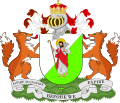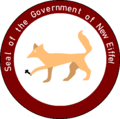Borders of New Eiffel

The Principality of New Eiffel, an erstwhile micronation enclaved within the United Kingdom of Great Britain and Northern Ireland, shared a 156-metre (511 ft) long border with the macronation. Shaped like an expanding rectangle, the principality had four named borders as designated by the four cardinal directions (points of the compass). Two of these had border barriers for their entire lengths, and only the other two had legal crossing points. New Eiffel also had three cities which acted as municipalities. However, unlike international borders, city borders had no barriers nor were they ever indicated with signage nor any other indicators.
The North and South Borders had no border crossings due to being adjacent to private property on the British side; the East Border in New Leeds, known as the "main border" for its prominence, was the most frequently crossed border with between 950 to 1,300 documented crossings annually. It had no gate, leading directly to the driveway fronting the Main Building. The West Border was the most fortified border in New Eiffel with a metal spiked fence; its gate was locked and required permission to cross. Thus, it had only 20 to 45 documented crossings annually.
The British property claimed by New Eiffel, including its boundaries, was first defined in June 1936, with the only major territorial change being the acquisition of a strip of the driveway fronting an adjacent roadway on 28 October 1966 for the expansion of the public road. New Eiffel's macronational borders remained largely unchanged since the Republic of New Finland—a distant predecessor state to New Eiffel—first laid claim to the previously British territory on 4 January 2018. There was a minor territorial revision on 8 May 2019 which expanded the borders to include the border barriers instead of ending before them.
History
The Principality of New Eiffel was a micronation enclaved within the United Kingdom of Great Britain and Northern Ireland that existed between 11 August 2018 and 1 November 2020. The Republic of New Finland, its earliest predecessor state, was declared on 31 December 2017 by Zabëlle Skye and originally claimed a residential property with a sizeable garden and driveway in Pretoria, South Africa. On 4 January 2018, it laid claim to Skye's home in London, England, and the original South African territory was likely dissolved on 9 February. The British territory would continue to be the micronation's principal area (colloquially the "mainland") when it was succeeded by the Kingdom of New Finland on 4 June.
On 11 August, New Finland was finally succeeded by New Eiffel, which inherited all of its borders and, as with the Kingdom, kept them unchanged. New Eiffel's border with the United Kingdom was slightly redefined on 8 May 2019, with minor territorial expansions made on all four corners of the square-shaped micronation to include the border barriers; before, New Eiffel asserted that the barriers were property of the United Kingdom. New Eiffel inevitably dissolved on 1 November 2020 following an almost year-long political crisis, leading to the secession of all New Eiffelic land back to the United Kingdom.
The British property claimed by New Eiffel, including its boundaries, was constructed and defined in June 1936. The only major territorial change between then and the claim by New Finland was the acquisition of a strip of the driveway fronting the adjacent roadway that was acquired by the Minister of Transport, then-Barbara Castle, on 28 October 1966 for the expansion of the road. The property owners were given monetary compensation.
International borders
New Eiffel was enclaved entirely within the United Kingdom of Great Britain and Northern Ireland. Sharing a border of some 156 metres (511 feet) with the Greater London administrative area of England, a constitute state of the United Kingdom, the rectangle-shaped principality had four named borders as designated by the four cardinal directions (points of the compass). Three of these barriers consisted of border barriers for their entire lengths and only two had border crossings. The North and South Borders gradually expanded outwards, making the West Border almost a metre (3.2 feet) longer than the East Border. The New Eiffel–United Kingdom North and South Borders (both 68.2 metres; 224 feet) were adjacent to residential properties on both sides; the East Border (8.9 metres; 29 feet) in the city of New Leeds—colloquially referred to as the "main border" for its prominence—fronted a pavement and a public road. The West Border (9.7 metres; 32 feet) in the capital Új Repülő—known locally as the "back border"—fronted a small row of trees in a private golf course.
The East Border had no gate, while the border's barrier beside the entrance was a small brick wall with a steel topper. Fronting the border on the New Eiffelic side were three potted plants with lights for decoration. The West Border was the most fortified border, consisting of a metal fence and gate with sharp spikes and anti-climb paint. Both the North and South Borders, fronting all three New Eiffelic cities, had a hedgerow barrier consisting of bush and trees for their first 10 metres (33 feet). The North Border then followed a wooden fence adjacent to New Leeds Alley on the New Eiffelic side, while the South Border continued through a wall between the semi-detached Main Building and a house on the British side. Both borders then followed the wooden fence for a further 40 metres (131 feet)—the South Border going through the Plitvice Bomb Shelter—until terminating at the West Border.
Macronational crossing points
- See also: Transport in New Eiffel
Although the North and South Borders had no border crossings due to being adjacent to private property on the British side, the South Border could technically have been crossed via Plitvice Bomb Shelter which was located beneath the border barrier. The air-raid shelter was located near the J16. The East Border was the most frequently crossed border, with between 950 and 1,300 documented crossings annually. It had no gate, leading directly to the driveway fronting the Main Building; the rest of New Eiffel could be then entered via the entrance to the building, the front door of XCUT Therapy or New Leeds Alley at the northernmost point which bypassed both houses. The West Border, as the most fortified border in New Eiffel, had only 20 to 45 documented crossings annually. Located at the end of the Main Route 1 in ǃkhās Street, the gate to the border was permanently locked and required strict permission from the government to enter or exit from.
| Border | Crossing | Annual crossings |
|---|---|---|
| North Border | ||
| East Border | XCUT Therapy Parking, New Leeds | 950–1,300 |
| South Border | Plitvice Bomb Shelter, Plitvice | 2–3 |
| West Border | ǃkhās Street, Main Route 1, Új Repülő | 20–45 |
City borders

New Eiffel had three cities which acted as municipalities—New Leeds, the only city with a permanent population; Plitvice; and the capital Új Repülő. Plitvice, which separated both cities, was thus the only city to border another. Unlike international borders, city borders had no barrier and were never indicated with signage nor any other indicators. When the cities were first designated in early January 2018, their borders were chosen based on the terrain. New Leeds consisted of the Main Building, its driveway and Seat Square, while Plitvice comprised the majority of the Rugbull Field and New Eiffel Gardens.
In contrast, Új Repülő consisted of almost no grass and several structures and paved or dirt roads. New Finland Monument was easily chosen as the boundary between Plitvice and Új Repülő. The New Leeds–Plitvice border was, on the other hand, difficult to define, and it was not until early 2019 that the end of Seat Square would be decided as the boundary.
New Leeds had two roads crossing into Plitvice: the fully-paved Main Route 1 via Norton Street to the north, and the unpaved J16 via Smith Street to the south. The J16 lead into Új Repülő via two roads—Dead Tree Lane's Dead Tree Street in Dead Tree, southern Új Repülő, and Prince Zabëlle I Road's Diamond Street in the centre of Új Repülő near New Eiffel School Playground, passing New Finland Monument—an apple tree. The Main Route 1's Norton Street also connected directly to northern Új Repülő via Gæ Pis Street, also passing New Finland Monument.





